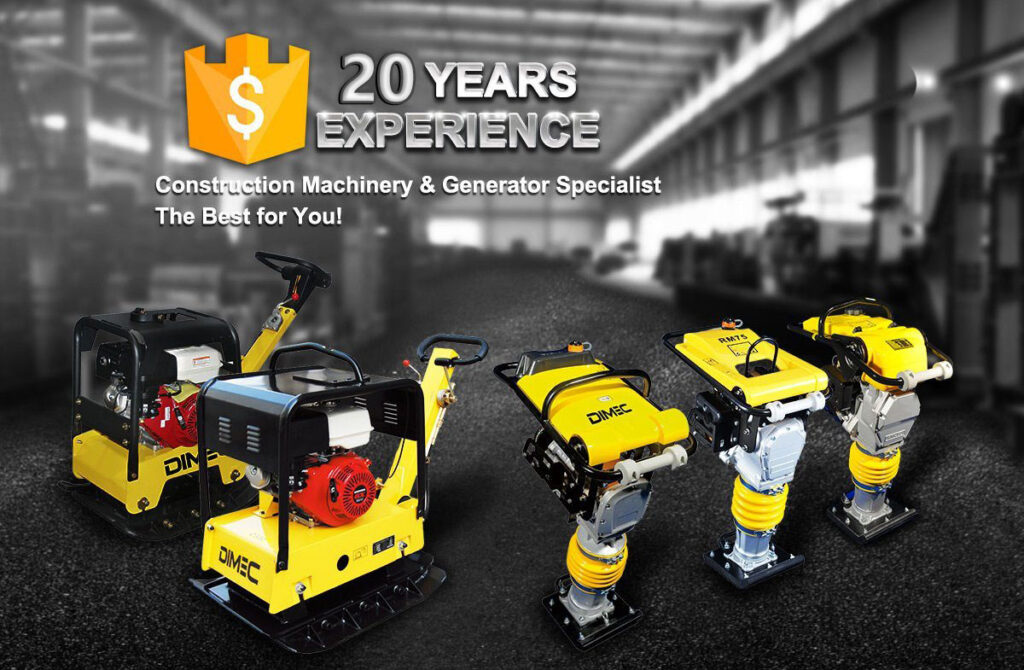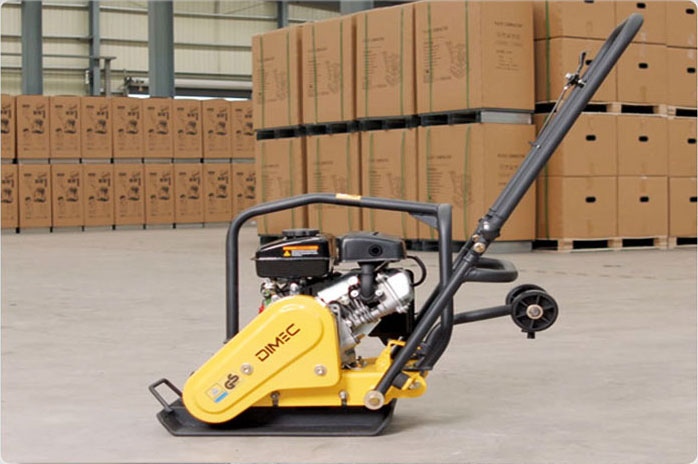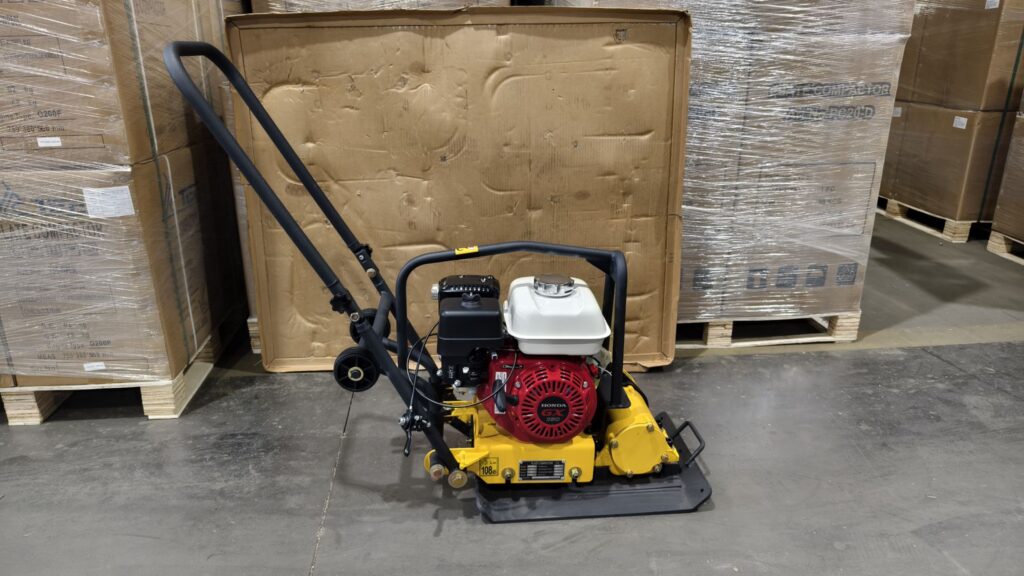Plate Compactor PME‑C50 vs Compactor Plate PME‑C60: In-Depth Product Comparison
- DIMEC
- Compactor Plate, Plate Compactor
Home » Plate Compactor PME‑C50 vs Compactor Plate PME‑C60: In-Depth Product Comparison

Table of Contents
Soil compaction is a critical step in construction and landscaping projects. In this comparison, we’ll take a close look at the Plate Compactor PME-C50 and the Compactor Plate PME-C60 to help you make the right choice.
Technical Specification
| Model | Plate Compactor PME-C50 |
|---|---|
| Engine | Loncin LC152F |
| Engine type | Air-cooled, single cylinder, 4-stroke, petrol engine / diesel engine |
| Frequency [VPM] | 5200 |
| Centrifugal force [KN] | 9 |
| Plate size (LxW) [cm] | 43x31 |
| Max.compaction depth[cm] | 20 |
| Travel speed [m/min] | 20 |
| Max.inclination angle | 20 |
| N.W./G.W. [kg] | 54/58 |
| Package (LxWxH) [cm] | 69x38x53 |
| Model | Compactor Plate PME-C60 |
|---|---|
| Engine | Honda / Robin / Loncin / Diesel engine |
| Engine type | Air-cooled, single cylinder, 4-stroke, petrol engine / diesel engine |
| Frequency [VPM] | 5600 |
| Centrifugal force [KN] | 12 |
| Plate size (LxW) [cm] | 50x36 |
| Max.compaction depth[cm] | 28 |
| Travel speed [m/min] | 25 |
| Max.inclination angle | 20° |
| N.W./G.W. [kg] | 65/70 |
| Package (LxWxH) [cm] | 75x38x56 |
1. Plate Size and Compaction Force
The Plate Compactor PME-C50 features a 43 x 31 cm cast iron base plate. This plate size is optimized for precision compaction in smaller areas. It generates a centrifugal force of 9 KN, which is sufficient for tasks like compacting soil for residential driveways, patios, and small garden paths.
The Compactor Plate PME-C60, on the other hand, has a larger 50 x 36 cm plate. This increased plate size results in a higher compaction force of 12 KN. It’s ideal for large-scale projects such as extensive roadways, large parking lots, and high-traffic commercial areas, where a deeper and more uniform compaction is required.
2. Engine Power and Efficiency
The PME-C50 is powered by a 2.5 HP Loncin LC152F engine, with petrol and diesel options available. This engine provides reliable power for medium-duty compaction tasks. It’s suitable for projects where speed is not the primary concern, but precision and versatility are key.
The PME-C60, however, offers more power. It can be equipped with a 5.5 HP Loncin G200F engine or a Honda GX160 engine. This extra power allows for faster compaction over larger areas and deeper soils. In a large-scale construction project in [City Name], the PME-C60 reduced the compaction time by [X] days compared to using a smaller machine, thanks to its powerful engine and larger plate.
3. Vibration Frequency and Compaction Speed
The PME-C50 operates at a vibration frequency of 5200 VPM. This frequency is well-suited for most residential and small commercial applications, ensuring a uniform compaction.
The PME-C60 has a higher vibration frequency of 5600 VPM. Coupled with its larger plate, it can achieve a higher compaction capacity, up to 380 m²/h. This makes it a great choice for projects where time is of the essence and large areas need to be compacted quickly.
4. Applications
For residential and light commercial projects, the PME-C50 is an excellent choice. Its compact size and maneuverability make it easy to use in small spaces. It’s perfect for DIY enthusiasts and small-scale contractors working on projects like building a small patio or repairing a local driveway.
The PME-C60 is designed for heavy-duty and high-volume work. It’s ideal for large road construction projects, large-scale paving, and areas with heavy traffic. Its ability to achieve deep compaction and cover large areas quickly makes it a favorite among large construction companies.
5. User-Friendly Design and Maintenance
Both machines are designed with the operator in mind. The PME-C50 has a low-vibration system and ergonomic controls, reducing operator fatigue during extended use. The PME-C60 also features advanced shock absorption and user-friendly controls, making it comfortable to operate even during long hours of heavy-duty work.
Maintenance is important for both machines. The PME-C50’s robust build and high-strength components ensure durability, and regular maintenance like checking the engine oil and air filter keeps it in good condition. The PME-C60, built for heavy-duty use, has components engineered to withstand higher forces, and routine maintenance is essential to keep it performing at its best.
6. Cost-Effectiveness
The PME-C50 offers great value for smaller projects. Its reliable performance without excessive power means you’re not paying for more than you need. It’s a cost-effective option for small contractors and DIYers.
The PME-C60, although it has a higher initial cost, can be more cost-effective in the long run for large projects. Its ability to complete jobs faster reduces labor costs and overall project timelines, providing a higher return on investment.
7. Interactive Section
Do you have any questions about choosing between the PME-C50 and PME-C60 for your project? Leave your questions in the comments below, and we’ll do our best to answer them. If you’ve used either of these machines, share your experiences and tips with other readers.
In summary, the choice between the Plate Compactor PME-C50 and the Compactor Plate PME-C60 depends on the scale and nature of your project. Consider your project requirements carefully to make the best decision.
Plate Compactor X Tamping Rammer X Road Roller
Feel free to contact us for any questions and doubts
You May Also Like
Mini Concrete Mixer: The Ultimate Guide for Efficient Mixing and Construction
Table of Contents When it comes to construction, whether you’re a seasoned pro or a DIY enthusiast, having the right tools can make all the difference. One such tool that has gained immense popularity is the mini concrete mixer. But what exactly is it, and why should you consider using one? Let’s dive into the world of mini concrete mixers and explore everything you need to know! What is a Mini Concrete Mixer? Definition and Purpose A mini concrete mixer is a compact machine designed to mix concrete efficiently and effectively. Unlike traditional concrete mixers, which can be bulky and cumbersome, mini mixers are lightweight and portable, making them ideal for small to medium-sized projects. Whether you’re pouring a patio, ...
Read More →
What Are the Different Types of Vibratory Roller Compactors?
Table of Contents In the construction world, having the right tools for the job is crucial. One of the essential tools for ensuring a solid foundation is the vibratory roller compactor. But what exactly are these machines, and how do they differ? Let’s dive into the world of vibratory roller compactors to understand their types, applications, and benefits. Understanding Vibratory Roller Compactors Definition and Function A vibratory roller compactor is a heavy-duty machine used to compact soil, asphalt, and other materials during construction projects. These rollers apply both static and dynamic forces to the material underneath, ensuring a denser and more stable base. Basic Working Principle The fundamental principle behind a vibratory roller compactor involves the combination of weight and ...
Read More →
What Are the Different Types of Earth Ramming Equipment?
Table of Contents Introduction Earth ramming is a crucial process in construction and landscaping, where the ground must be compacted to provide a solid foundation. Whether you’re preparing the soil for a building, road, or landscaping project, choosing the right earth ramming equipment is essential for achieving the desired results. With a wide variety of ramming tools available, it’s vital to understand their differences, uses, and advantages. This article will delve into the different types of earth ramming equipment, helping you make informed decisions for your next project. Hand-Operated Rammers Tamping Rammers Features of Tamping Rammers Tamping rammers are a staple in the construction industry, especially for smaller projects that require manual compaction. These hand-operated tools are designed to be ...
Read More →
How to Select the Best Diesel Welder Generator for Your Needs
Table of Contents Introduction Choosing the right diesel welder generator can make a significant difference in your work efficiency and overall productivity. Whether you’re a professional welder, a contractor, or a hobbyist, understanding the features and benefits of diesel welder generators is crucial for making an informed purchase. This guide will help you navigate the various options, features, and considerations to ensure you choose the best diesel welder generator for your specific needs. Understanding Diesel Welder Generators What is a Diesel Welder Generator? A diesel welder generator is a versatile piece of equipment that combines the functionality of a welder and a generator. It uses diesel fuel to generate electrical power, which can then be used for welding and other ...
Read More →
The Ultimate Guide to Jumping Jack Compactors: Everything You Need to Know
Table of Contents Introduction to Jumping Jack Compactors Jumping Jack Compactors, often referred to as rammer compactors, are essential tools in the construction and landscaping industries. Designed to compact soil and other materials, these machines deliver powerful, high-impact force to create a solid and stable surface. First developed in the early 20th century, they have since evolved into sophisticated equipment that meets the demands of modern construction projects. How Does a Jumping Jack Compactor Work? Jumping Jack Compactors operate by using a piston-driven system that generates a rapid tamping motion. Key components include a heavy-duty engine, spring-loaded piston, and a durable plate. The science behind their effectiveness lies in their ability to apply high-frequency vibrations and impact forces that eliminate ...
Read More →
What Are the Advantages of Using a Pneumatic Roller Over Other Types?
Table of Contents Introduction Choosing the right road roller for construction and compaction projects is crucial for achieving optimal results. Among the various types available, pneumatic rollers stand out for their unique advantages and superior performance. So, what exactly are the advantages of using a pneumatic roller over other types? Let’s dive in and explore. Types of Rollers When it comes to rollers, there are several types to choose from, including static rollers, vibratory rollers, and pneumatic rollers. Each type has its own set of benefits and drawbacks. For instance, static rollers are known for their simplicity and durability, while vibratory rollers excel in high-frequency applications. However, pneumatic rollers offer a unique combination of features that make them particularly advantageous in a ...
Read More →

Plate Compactor
Plate compactors are our super star products. We have the most complete plate compactor models from 40KG to 750KG, which can suitable for different working conditions.

Tamping Rammer
We have 9 models different tamping rammers from 32kg to 90kg, with Honda, Robin, Loncin etc world famous brand engines, low energy consumption and more durable.

Road Roller
Road rollers for efficient and precise compaction in road construction. We offer a comprehensive range of models from 0.3-ton to 5.5-ton capacity, designed to handle asphalt, soil, and gravel with unmatched stability.

